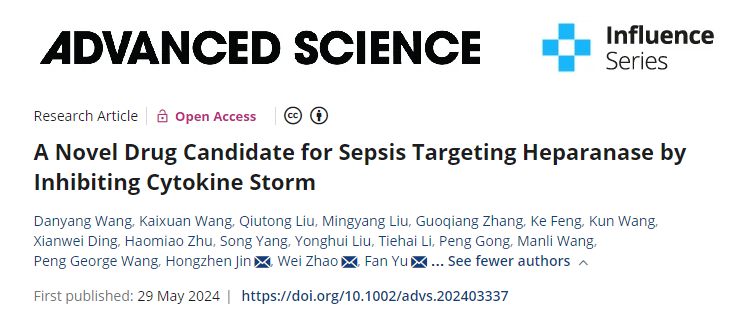“Sugar-coated Guard”: Guarding Vascular Barrier and Leading the Way in Sepsis Treatment
The team led by Professor Zhao Wei of Nankai University and the team led by Professor Yu Fan of University of Health and Rehabilitation Sciences jointly published a research paper entitled “A Novel Drug Candidate for Sepsis Targeting Heparanase by Inhibiting Cytokine Storm” in Advanced Science online. This groundbreaking study offers a new treatment strategy for sepsis, a disease with one of the lowest drug development success rates worldwide, to protect the vascular endothelial barrier. Based on this strategy, the research team developed CV122, an oligosaccharide heparanase inhibitor, and explored its potential in the treatment of sepsis. CV122 acts as a “sugar-coated guard,” accurately targeting heparanase and effectively reducing the degradation of vascular endothelial glycocalyx, thereby maintaining the integrity of the vascular barrier. This innovative idea of treatment not only helps to regulate the body’s immune response but also effectively guards key organs, such as the lungs against inflammation. A series of rigorous experiments show that CV122 has demonstrated strong therapeutic potential in various animal models, and can significantly improve the survival rate of mice with sepsis. This proves the potential of CV122 as a drug candidate with a clear target, excellent efficacy and broad spectrum of therapeutic effects. More importantly, it points out a new way for the treatment of sepsis based on innovative idea to protect the vascular barrier.

In this study, the oligosaccharide compound CV122 was designed and synthesized based on the structure-activity relationship (SAR) between the crystal structure of heparanase and its substrate. In vitro and in vivo experiments showed that it had strong inhibitory activity for heparinase. Further mechanistic studies confirmed that CV122 significantly inhibited the release of early cytokines in two sepsis model mice, induced by lipopolysaccharide (LPS) and cecum ligation and puncture (CLP), thereby blocking the formation of cytokine storms. Additionally, it effectively reduced the degradation of glycocalyx in vascular endothelial cells, protecting the integrity of the vascular endothelial barrier, and then preventing the damage of multiple organs such as lung, kidney, and liver. Finally, the paper verified that CV122 significantly improves survival (from 0% to 80%-100%) by constructing three models of mice with LPS, CLP, and Crimean-Congo hemorrhagic fever virus (CCHFV). In summary, CV122 has been proven to improve survival and effectively relieve sepsis in three models of endotoxin, bacterial and viral infection, demonstrating strong efficacy and broad therapeutic effect, and significant potential as a drug candidate.

Diagram of the mechanism model
In summary, this study developed the drug candidate CV122 by targeting heparanase, based on the innovative strategy of protecting the integrity of the vascular endothelial barrier. This approach offers a crucial insight and lays the foundations for the development of sepsis treatments, marking a groundbreaking advancement in the field.
Wang Danyang and Wang Kaixuan, doctoral students from Nankai University, are the co-first authors of the paper, and Professor Zhao Wei of Nankai University, Professor Yu Fan and Dr. Jin Hongzhen of University of Health and Rehabilitation Sciences are the co-corresponding authors. Nankai University is the first affiliation for this research.
URL:
https://onlinelibrary.wiley.com/doi/10.1002/advs.202403337
(Edited and translated by Nankai News Team.)









